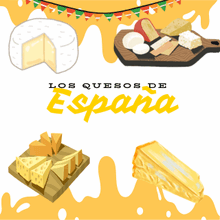On March 27th, World Cheese Day is celebrated, and in honour of this special day, we’ve decided to take it out of the sandwich! In Spain, cheese culture is much more than just an accompaniment; it’s a tradition that has lasted for centuries.
With over 150 varieties of cheese and 26 Protected Designations of Origin (PDO), Spanish cheese is a gastronomic gem that lies at the heart of many traditional recipes and on the tables of Spaniards every day. If you’re learning Spanish and plan to study here, get ready to discover a variety of cheeses that will make your mouth water. Join us on this delicious journey through Spain’s most authentic flavours!
🧀 Varieties of Cheese in Spain: A Burst of Flavours!
Cheese in Spain has a very rich history, and it’s produced all over the country, from the mountains to the coastlines. Each region has its own typical cheese, creating an impressive diversity of flavours and textures. Here are some of the most iconic cheeses:
Manchego Cheese (The Most Iconic!): made from Manchega sheep’s milk, this cheese is probably the most famous Spanish cheese. Its flavour is unmistakable, and it can be enjoyed in different degrees of maturity. Manchego can mature between 30 days and 2 years, giving it a range of flavours that go from mild and dairy-like to intense and spicy. It’s perfect to pair with a good red wine, in tapas, or as part of a traditional Spanish meal. It’s one of those cheeses that can never be missing from a traditional dinner.
Cabrales: if you love bold cheeses, Cabrales is ideal. This blue cheese from Asturias has a strong flavour and a very distinctive aroma. It matures in the caves of the Picos de Europa, where the blue mould is created, giving it its characteristic appearance and flavour. It’s perfect for those looking for a more intense experience in the world of cheese.
Idiazábal: originating from the Basque Country and Navarre, this sheep’s cheese is smoked with woods such as beech or cherry, giving it a unique and very special flavour. If you love cheeses with a smoky touch, Idiazábal is for you! Its texture is firm, and its flavour is mild, with an intensity that leaves no one indifferent.
Torta del Casar: from the Extremadura region, Torta del Casar is one of the creamiest and most delicious cheeses. Made with Merino sheep’s milk, its texture is creamy and its flavour intense, with a slight bitterness that makes it perfect to spread on bread or pair with nuts. Ideal for those who enjoy a cheese that’s both creamy and full of flavour.
Mahón: hailing from the island of Menorca, this cheese has a semi-hard texture and a slightly salty taste. Its orange rind is achieved through the traditional process of rubbing it with oil and paprika. Mahón cheese is perfect for enjoying on its own or pairing with Mediterranean dishes.
🧀 Typical Cheeses by Region: A Unique Flavour in Every Corner of Spain
In Spain, every autonomous community has its own typical cheese, and each one reflects the country’s geographical and cultural diversity. From the green mountains of Asturias to the sunny Canary Islands, Spanish cheese is a true gastronomic treasure. Here are some regional cheeses you can’t miss:
Asturias: with iconic cheeses like Cabrales, this principality is famous for its blue cheeses. Other notable Asturian cheeses include Afuegal’ Pitu (a creamy and slightly spicy cheese) and Gamonedo, which combines smoky flavour with the intensity of blue cheeses.
Murcia: in the Murcia region, the Murcia Cheese (made from goat’s milk) is very popular for its mild flavour and creamy texture. Additionally, Murcia Cheese soaked in wine is a cheese immersed in red wine, which gives it a unique taste and aroma, making it an irresistible treat.
Galicia: Galicia is known for its excellent Tetilla cheese, which has a distinctive conical shape and a smooth texture. The Arzúa-Ulloa is another Galician cheese that stands out for its creaminess and dairy flavour, while San Simón da Costa, smoked with birch wood, offers a deep and characteristic flavour that represents Galician identity.
Catalonia: the Catalonia region has cheeses like L’Alt Urgell and Cerdanya, made from cow’s milk, with a creamy texture and a very mild dairy flavour. These cheeses are perfect for those who prefer more subtle flavours.
🧀 Types of Cheese by Maturation: Discover Their Nuances
Depending on how long a cheese matures, its flavours and textures can var significantly. In Spain, cheeses are generally classified as:
Fresh: these cheeses are not matured, like Burgos cheese. They have a smooth texture and a delicate flavour.
Semi-Cured: these cheeses mature for 2 to 3 months, giving them a more pronounced flavour and a slightly firmer texture.
Cured: with more than 4 months of maturation, cured cheeses have intense flavours and a harder texture.
Blue: blue cheeses, such as Cabrales, have a strong flavour and unmistakable aroma due to the mould that develops during maturation.
👀 Curiosities About Cheese in Spain: Surprising Facts
In Spain, there are 27 cheeses with Protected Designation of Origin (PDO), ensuring these products are authentic and made using traditional methods.
The most expensive cheese in Spain is Cabrales, which has been auctioned for more than €30,000. A true delicacy!
Manchego has such a rich history that it appears in the literary work Don Quixote de la Mancha by Cervantes, making it a symbol of Spanish culture.
In Menorca, Mahón cheese is still made using traditional methods, with cotton cloths to give it its characteristic square shape.
In Galicia, Tetilla cheese is not only famous in gastronomy but has also become a symbol of regional identity—it’s even used in local festivals!
🌍 Cheeses of Spain Around the World: A Global Tradition
Spanish cheeses have a huge impact all over the world, not just in Europe. Spain’s cheese-making tradition extends to other countries, such as France, Italy, and Switzerland, which also have a wide variety of artisan cheeses, many of which share similar characteristics with Spanish cheeses. For example, Manchego cheese is comparable to Italian Pecorino Romano, as both are made from sheep’s milk. However, each one has its unique touch thanks to traditional production methods and the milk used, making them distinct.
Additionally, in Mexico and Argentina, countries with strong Spanish influences, Manchego cheese is widely consumed and often used in their typical dishes, such as tacos or empanadas. This shows how Spain’s cheese-making tradition has crossed borders and continues to be a global reference.
🎉 Activities to Celebrate World Cheese Day
If you’re wondering how to celebrate World Cheese Day on March 27th, here are some fun ideas:
Cheese Tasting: organise a Spanish cheese tasting, where you can try different varieties like Manchego, Cabrales, Mahón, or Torta del Casar, paired with a good Spanish wine. It’s an excellent way to explore flavours and enjoy a good time!
Cooking Classes: participate in a Spanish cooking class and learn how to prepare traditional dishes that include cheese, like cheese tortilla or Manchego cheese croquettes. A delicious way to improve your Spanish and your palate!
Visit a Cheese Factory: if you have the chance to travel to Spain, visit one of the many local cheese factories to see how these artisan cheeses are made. You’ll get to see the production process and enjoy a very educational and tasty experience.
Online Cheese Event: if you can’t be in Spain, look for virtual cheese-tasting events or online conferences about Spanish cheese. Many companies host events through platforms like Zoom to teach you more about the history, culture, and production of Spanish cheeses.
✅ Try Cheese and Improve Your Spanish!
If you’re learning Spanish, a great way to immerse yourself in the culture is by trying Spanish cheeses. It’s also a delicious way to learn food-related vocabulary and local traditions. And here’s an expression that may be useful: “darle la vuelta a la tortilla,” which means to turn a situation to your advantage (although it’s not related to cheese, it’s very Spanish! 😉).
Celebrate World Cheese Day on March 27th with a good piece of Manchego or Cabrales, and enjoy the authentic taste of Spain. ¡Buen provecho! (Enjoy your meal!)




